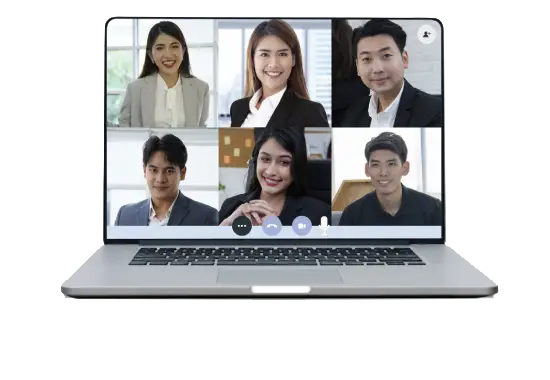Video conferencing




Video Conferencing
Video conferencing is a technology that allows individuals or groups to communicate in real-time via video and audio over the internet, eliminating the need for physical meetings. It combines video and voice communication, enabling face-to-face interaction across distances. Video conferencing solutions have become essential tools for businesses, educational institutions, healthcare providers, and individuals, transforming how people collaborate, learn, and work together without the limitations of geography.
Video conferencing systems use a combination of hardware (cameras, microphones, and displays) and software platforms that facilitate the transmission of video and audio signals over the internet. The process involves:
- Video Capture: Cameras capture the participants' images and stream them to others in the meeting.
- Audio Capture: Microphones capture voices and transmit sound to other participants.
- Transmission: Data is sent over the internet through the software platform, allowing participants to view and hear each other in real-time.
- Display and Output: The transmitted video and audio signals are displayed on monitors or screens, allowing users to see and hear each other.

Video conferencing can be hosted on a wide range of devices, from desktop computers and laptops to mobile devices such as smartphones and tablets.
Key Features of Video Conferencing Solutions:
1. High-Quality Video and Audio:
- High-definition (HD) video and clear audio are critical components of a successful video conference. Most modern video conferencing platforms support HD video, noise-cancelling microphones, and echo reduction technologies to ensure clear communication.
2. Screen Sharing:
- Screen sharing allows participants to display their screen content, such as presentations, documents, or software applications, with others in real-time. This feature is especially useful for meetings, presentations, and collaborative work.
3. Real-Time Chat and Messaging:
- Many video conferencing tools include built-in chat features that allow participants to send text messages, links, or files while the meeting is in progress. This can enhance communication and enable real-time collaboration without interrupting the video feed.
4. Recording and Playback:
- Video conferencing platforms often allow meetings to be recorded for future reference. This is especially helpful for participants who are unable to attend or for review purposes. Meeting recordings can be stored in the cloud or on local storage for easy access.
5. Virtual Backgrounds:
- Virtual backgrounds allow participants to replace their actual background with a digital image or blur the surroundings to ensure privacy and minimize distractions. This feature is popular in professional settings where participants want to maintain a polished appearance or hide their environment.
6. Multi-Device Support:
- Video conferencing solutions can be used on multiple devices, including computers, smartphones, tablets, and conference room systems. This flexibility ensures that users can participate in meetings from anywhere, at any time, using the device of their choice.
7. Breakout Rooms:
- Breakout rooms allow large meetings to be divided into smaller groups for more focused discussions. Participants can be assigned to different rooms within the same meeting to facilitate collaboration in a more intimate setting before reconvening for a larger discussion.
1. Integrations with Other Tools:
- Many video conferencing platforms integrate seamlessly with other business tools, such as project management software, calendars, and document sharing platforms (like Google Drive, Dropbox, and Microsoft Teams). This helps streamline workflows and enhances productivity.
Benefits of Video Conferencing:
1. Reduced Travel Costs and Time:
One of the most significant advantages of video conferencing is the ability to eliminate travel time and expenses associated with in-person meetings. Organizations can connect with remote teams, clients, and partners without the need for flights, hotels, or long commutes.
2. Increased Productivity and Collaborationy:
Video conferencing enables real-time communication, fostering collaboration regardless of geographical locations. Teams can discuss, share ideas, and make decisions without delays, leading to faster project timelines and improved efficiency.
3. Accessibility and Flexibility:
Video conferencing makes it easy for people to participate in meetings from anywhere in the world, providing flexibility for remote work, international teams, or anyone who might be unable to attend in person due to location or time constraints.
4. Improved Communication and Engagement:
Unlike emails or phone calls, video conferencing allows participants to see facial expressions and body language, enhancing communication and making it more personal and engaging. This can lead to a better understanding of the message being conveyed.
5. Enhanced Learning and Education:
Video conferencing has transformed the education sector by facilitating remote learning and virtual classrooms. Students and educators can connect in real-time for lectures, discussions, and collaborative projects, even if they are miles apart.
6. Better Work-Life Balance:
Video conferencing supports flexible work environments by enabling employees to work from home or any remote location. This can contribute to better work-life balance, increased job satisfaction, and higher employee retention.
7. Environmentally Friendly:
Reducing the need for business travel lowers an organization’s carbon footprint, making video conferencing an eco-friendly communication alternative. Fewer in-person meetings mean less use of vehicles, planes, and other transportation modes.
